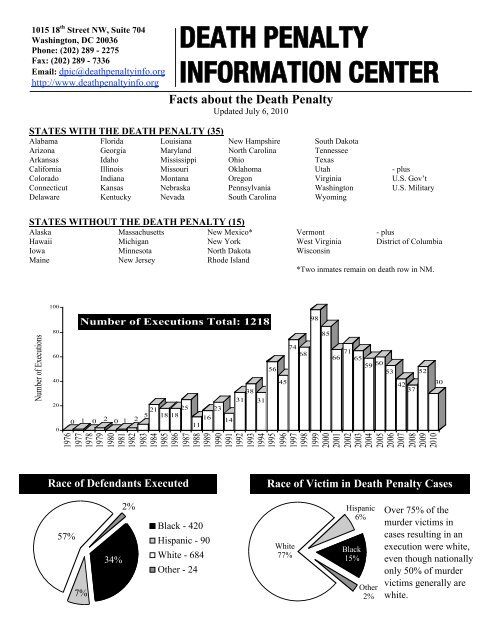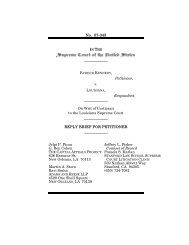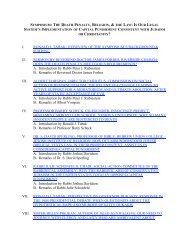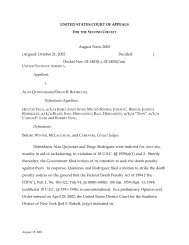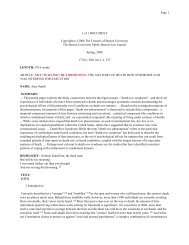DEATH PENALTY INFORMATION CENTER
DEATH PENALTY INFORMATION CENTER
DEATH PENALTY INFORMATION CENTER
You also want an ePaper? Increase the reach of your titles
YUMPU automatically turns print PDFs into web optimized ePapers that Google loves.
1015 18 th Street NW, Suite 704<br />
Washington, DC 20036<br />
Phone: (202) 289 - 2275<br />
Fax: (202) 289 - 7336<br />
Email: dpic@deathpenaltyinfo.org<br />
http://www.deathpenaltyinfo.org<br />
<strong>DEATH</strong> <strong>PENALTY</strong><br />
<strong>INFORMATION</strong> <strong>CENTER</strong><br />
Facts about the Death Penalty<br />
Updated July 6, 2010<br />
STATES WITH THE <strong>DEATH</strong> <strong>PENALTY</strong> (35)<br />
Alabama Florida Louisiana New Hampshire South Dakota<br />
Arizona Georgia Maryland North Carolina Tennessee<br />
Arkansas Idaho Mississippi Ohio Texas<br />
California Illinois Missouri Oklahoma Utah - plus<br />
Colorado Indiana Montana Oregon Virginia U.S. Gov’t<br />
Connecticut Kansas Nebraska Pennsylvania Washington U.S. Military<br />
Delaware Kentucky Nevada South Carolina Wyoming<br />
STATES WITHOUT THE <strong>DEATH</strong> <strong>PENALTY</strong> (15)<br />
Alaska Massachusetts New Mexico* Vermont - plus<br />
Hawaii Michigan New York West Virginia District of Columbia<br />
Iowa Minnesota North Dakota Wisconsin<br />
Maine New Jersey Rhode Island<br />
*Two inmates remain on death row in NM.<br />
100<br />
Number of Executions<br />
80<br />
60<br />
40<br />
20<br />
0<br />
Number of Executions Total: 1218<br />
0 1 0 2 0 1 2 5 21 25<br />
18 18<br />
16<br />
11<br />
23<br />
14<br />
38<br />
31 31<br />
56<br />
45<br />
74<br />
68<br />
98<br />
85<br />
66 71 65<br />
59 60 53<br />
42<br />
37<br />
52<br />
1976<br />
1977<br />
1978<br />
1979<br />
1980<br />
1981<br />
1982<br />
1983<br />
1984<br />
1985<br />
1986<br />
1987<br />
1988<br />
1989<br />
1990<br />
1991<br />
1992<br />
1993<br />
1994<br />
1995<br />
1996<br />
1997<br />
1998<br />
1999<br />
2000<br />
2001<br />
2002<br />
2003<br />
2004<br />
2005<br />
2006<br />
2007<br />
2008<br />
2009<br />
2010<br />
30<br />
Race of Defendants Executed<br />
Race of Victim in Death Penalty Cases<br />
57%<br />
7%<br />
34%<br />
2%<br />
Black - 420<br />
Hispanic - 90<br />
White - 684<br />
Other - 24<br />
White<br />
77%<br />
Hispanic<br />
6%<br />
Black<br />
15%<br />
Other<br />
2%<br />
Over 75% of the<br />
murder victims in<br />
cases resulting in an<br />
execution were white,<br />
even though nationally<br />
only 50% of murder<br />
victims generally are<br />
white.
Recent Studies on Race<br />
• In 96% of the states where there have been reviews of race<br />
and the death penalty, there was a pattern of either race-ofvictim<br />
or race-of-defendant discrimination, or both. (Prof.<br />
David Baldus report to the ABA, 1998).<br />
• 98% of the chief district attorneys in death penalty states<br />
are white; only 1% are black. (Prof. Jeffrey Pokorak,<br />
Cornell Law Review, 1998).<br />
• A comprehensive study of the death penalty in North Carolina found that the odds of receiving a death sentence rose by 3.5 times<br />
among those defendants whose victims were white. (Prof. Jack Boger and Dr. Isaac Unah, University of North Carolina, 2001).<br />
• A study in California found that those who killed whites were over 3 times more likely to be sentenced to death than those who<br />
killed blacks and over 4 times more likely than those who killed Latinos. (Pierce & Radelet, Santa Clara Law Review 2005).<br />
Innocence<br />
White Def./<br />
Black Victim<br />
Black Def./<br />
White Victim<br />
Persons Executed for Interracial Murders<br />
15<br />
244<br />
Number Released Since 1973<br />
12%<br />
25<br />
20<br />
15<br />
10<br />
5<br />
0<br />
23<br />
20<br />
42%<br />
11 10<br />
8 8<br />
7<br />
6 6 5 5 4 3 3 3 3 2 2 2 1 1 1 1 1 1 1<br />
WA<br />
VA<br />
NV<br />
NE<br />
MD<br />
KY<br />
IN<br />
ID<br />
TN<br />
SC<br />
MS<br />
MO<br />
MA<br />
OH<br />
NM<br />
CA<br />
GA<br />
AL<br />
PA<br />
NC<br />
LA<br />
AZ<br />
TX<br />
OK<br />
FL<br />
IL<br />
States Where Inmates Have Been Released<br />
Race of Death Row Inmates<br />
44%<br />
Death Row Exonerations by State<br />
Total: 138<br />
2%<br />
Black - 42%<br />
Hispanic - 12%<br />
White - 44%<br />
Other - 2%<br />
2 I<br />
Since 1973, over 130 people have<br />
been released from death row with<br />
evidence of their innocence. (Staff<br />
Report, House Judiciary<br />
Subcommittee on Civil &<br />
Constitutional Rights, Oct. 1993, with<br />
updates from DPIC).<br />
From 1973-1999, there was an<br />
average of 3.1 exonerations per<br />
year. From 2000-2007, there has<br />
been an average of 5 exonerations<br />
per year.<br />
<strong>DEATH</strong> ROW INMATES BY STATE: October 1, 2009<br />
California 694 S. Carolina 63 Connecticut 10<br />
Florida 395 Mississippi 59 Kansas 10<br />
Texas 339 U.S. Gov’t 58 Utah 10<br />
Pennsylvania 223 Missouri 52 Washington 9<br />
Alabama 201 Arkansas 42 U.S. Military 8<br />
Ohio 170 Kentucky 36 Maryland 5<br />
N. Carolina 169 Oregon 33 S. Dakota 3<br />
Arizona 132 Delaware 19 Colorado 3<br />
Georgia 108 Idaho 18 Montana 2<br />
Tennessee 90 Indiana 16 New Mexico 2<br />
Oklahoma 85 Virginia 16 Wyoming 1<br />
Louisiana 84 Illinois 15 N. Hampshire 1<br />
Nevada 78 Nebraska 11 TOTAL 3263<br />
Race of Death Row Inmates and Death Row Inmates by State Source: NAACP LDF “Death Row, U.S.A.” (October 1, 2009)<br />
When added, the total number of death row inmates by state is slightly higher because some prisoners are sentenced to death in more than one state.
NUMBER OF EXECUTIONS BY STATE SINCE 1976<br />
Total 2010 2009 Total 2010 2009<br />
Texas 461 14 24 Nevada 12 0 0<br />
Virginia 107 2 3 Mississippi 12 2 0<br />
Oklahoma 92 1 3 Utah 7 1 0<br />
Florida 69 1 2 Tennessee 6 0 2<br />
Missouri 67 0 1 Maryland 5 0 0<br />
Georgia 47 1 3 Washington 4 0 0<br />
Alabama 46 2 6 Nebraska 3 0 0<br />
N. Carolina 43 0 0 Pennsylvania 3 0 0<br />
S. Carolina 42 0 2 Kentucky 3 0 0<br />
Ohio 38 5 5 Montana 3 0 0<br />
Louisiana 28 1 0 Oregon 2 0 0<br />
Arkansas 27 0 0 Connecticut 1 0 0<br />
Arizona 23 0 0 Idaho 1 0 0<br />
Indiana 20 0 1 New Mexico 1 0 0<br />
Delaware 14 0 0 Colorado 1 0 0<br />
California 13 0 0 Wyoming 1 0 0<br />
Illinois 12 0 0 South Dakota 1 0 0<br />
US Gov’t 3 0 0<br />
<strong>DEATH</strong> SENTENCING<br />
The number of death sentences per year has dropped dramatically since 1999.<br />
88%<br />
7%<br />
5%<br />
Yes 5%<br />
No 88%<br />
No Opinion 7%<br />
8<br />
6<br />
4<br />
2<br />
0<br />
6.6<br />
1200<br />
1000<br />
800<br />
600<br />
400<br />
200<br />
0<br />
1005<br />
South<br />
4.8<br />
68<br />
West<br />
4.8<br />
141<br />
Midwest<br />
4.2<br />
5.4<br />
South West Midwest Northeast National<br />
4<br />
Northeast<br />
568<br />
TX &<br />
VA<br />
*Federal executions are listed in the region in which the crime<br />
was committed.<br />
Year 1993 1994 1995 1996 1997 1998 1999 2000 2001 2002 2003 2004 2005 2006 2007 2008 2009<br />
Sentences 295 328 326 323 281 306 284 235 167 169 154 140 138 122 119 111 106*<br />
Source: Bureau of Justice Statistics: “Capital Punishment 2008.” *Estimate based on DPIC's research.<br />
JUVENILES<br />
• In 2005, the Supreme Court in Roper v. Simmons struck down the death penalty for juveniles. 22 defendants had been executed for<br />
crimes committed as juveniles since 1976.<br />
MENTAL DISABILITIES<br />
• Intellectual Disabilities: In 2002, the Supreme Court held in Atkins v. Virginia that it is unconstitutional to execute defendants with<br />
'mental retardation.'<br />
• Mental Illness: The American Psychiatric Association, the American Psychological Association, the National Alliance for the<br />
Mentally Ill, and the American Bar Association have endorsed resolutions calling for an exemption of the severely mentally ill.<br />
WOMEN<br />
•There were 53 women on death row as of June 30, 2009. This constitutes 1.6% of the total death row population. 11 women have<br />
been executed since 1976. "Death Penalty For Female Offenders" by Victor L. Streib, (June 30, 2009)<br />
DETERRENCE<br />
Execution By Region*<br />
• According to a survey of the former and present presidents of the• Consistent with previous years, the 2008 FBI Uniform Crime<br />
country's top academic criminological societies, 88% of these Report showed that the South had the highest murder rate. The<br />
experts rejected the notion that the death penalty acts as a South accounts for over 80% of executions. The Northeast,<br />
deterrent to murder. (Radelet & Lacock, 2009)<br />
which has less than 1% of all executions, again had the lowest<br />
murder rate.<br />
Criminologists View of Deterrence<br />
Do executions lower<br />
homicide rates?<br />
Murder Rates per 100,000 - 2008
EXECUTIONS SINCE 1976 BY METHOD USED<br />
1044 Lethal Injection<br />
157 Electrocution<br />
11 Gas Chamber<br />
3 Hanging<br />
3 Firing Squad<br />
FINANCIAL FACTS ABOUT THE <strong>DEATH</strong> <strong>PENALTY</strong><br />
• The California death penalty system costs taxpayers $114 million per year beyond the costs of keeping convicts locked up for life.<br />
Taxpayers have paid more than $250 million for each of the state’s executions. (L.A. Times, March 6, 2005)<br />
• In Kansas, the costs of capital cases are 70% more expensive than comparable non-capital cases, including the costs of incarceration.<br />
(Kansas Performance Audit Report, December 2003).<br />
• In Maryland, an average death penalty case resulting in a death sentence costs approximately $3 million. The eventual costs to<br />
Maryland taxpayers for cases pursued 1978-1999 will be $186 million. Five executions have resulted. (Urban Institute 2008).<br />
• The most comprehensive study in the country found that the death penalty costs North Carolina $2.16 million per execution over the<br />
costs of sentencing murderers to life imprisonment. The majority of those costs occur at the trial level. (Duke University, May 1993).<br />
• Enforcing the death penalty costs Florida $51 million a year above what it would cost to punish all first-degree murderers with life in<br />
prison without parole. Based on the 44 executions Florida had carried out since 1976, that amounts to a cost of $24 million for each<br />
execution. (Palm Beach Post, January 4, 2000).<br />
• In Texas, a death penalty case costs an average of $2.3 million, about three times the cost of imprisoning someone in a single cell at<br />
the highest security level for 40 years. (Dallas Morning News, March 8, 1992).<br />
PUBLIC OPINION<br />
• The May 2006 Gallup Poll found that overall support of the<br />
death penalty was 65% (down from 80% in 1994). The same<br />
poll revealed that when respondents are given the choice of life<br />
without parole as an alternate sentencing option, more choose<br />
life without parole (48%) than the death penalty (47%).<br />
Support for Life Without Parole<br />
36 states plus the US government use lethal injection as their primary method. Some<br />
states utilizing lethal injection have other methods available as backups. Though New<br />
Mexico abolished the death penalty in 2009, the act was not retroactive, leaving two<br />
prisoners on death row and its lethal injection protocol intact.<br />
• A 2009 poll commissioned by DPIC found police chiefs ranked<br />
the death penalty last among ways to reduce violent crime. The<br />
police chiefs also considered the death penalty the least efficient<br />
use of taxpayers’ money.<br />
What Interferes with Effective Law Enforcement?<br />
Prefer Death Penalty<br />
47%<br />
Prefer Life Without<br />
Parole<br />
48%<br />
No<br />
Opinion<br />
5%<br />
Lack of law enforcement resource<br />
Drug/Alcohol abuse<br />
Family problems/child abuse<br />
Lack of programs for mentally ill<br />
Crowded courts<br />
Ineffective prosecution<br />
Too many guns<br />
Gangs<br />
Insufficient use of the death penalty<br />
3%<br />
2%<br />
7%<br />
6%<br />
5%<br />
14%<br />
12%<br />
20%<br />
20%<br />
0% 5% 10% 15% 20%<br />
Percent Ranking Item as One of Top Two or Three<br />
The Death Penalty Information Center has available more extensive reports on a variety of issues, including:<br />
"The Death Penalty in 2009: Year-End Report" (December 2009)<br />
“Smart on Crime: Reconsidering the Death Penalty in a Time of Economic Crisis” (October 2009)<br />
“The Death Penalty in 2008: A Year End Report” (December 2008)<br />
“A Crisis of Confidence: Americans' Doubts About the Death Penalty” (2007)<br />
“Blind Justice: Juries Deciding Life and Death with Only Half the Truth” (2005)<br />
“Innocence and the Crisis in the American Death Penalty” (2004)<br />
“International Perspectives on the Death Penalty: A Costly Isolation for the U.S.” (1999)<br />
“The Death Penalty in Black & White: Who Lives, Who Dies, Who Decides” (1998)<br />
“Innocence and the Death Penalty: The Increasing Danger of Executing the Innocent” (1997)<br />
“Killing for Votes: The Dangers of Politicizing the Death Penalty Process” (1996)<br />
“Twenty Years of Capital Punishment: A Re-evaluation” (1996)<br />
“With Justice for Few: The Growing Crisis in Death Penalty Representation” (1995)<br />
“On the Front Line: Law Enforcement Views on the Death Penalty” (1995)<br />
“The Future of the Death Penalty in the United States: A Texas-Sized Crisis” (1994)


